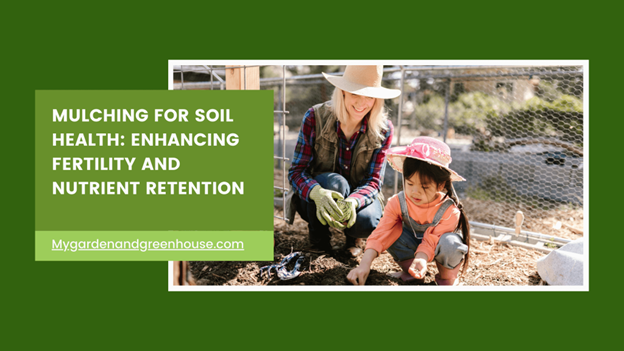
Maintaining soil health is crucial for sustainable agriculture and gardening practices. One effective technique that promotes soil fertility and nutrient retention is mulching. Mulching involves the application of organic or inorganic materials to the soil surface, providing numerous benefits for plant growth and overall soil quality. In this article, we will explore the concept of mulching, its various types, and the ways it enhances soil health.
What is Mulching?
Mulching refers to the process of covering the soil surface with a layer of organic or inorganic material. This protective layer offers numerous benefits, including weed suppression, moisture retention, temperature regulation, and nutrient cycling. By mulching, gardeners and farmers can improve the overall health and productivity of their soil.
Organic Mulches
Organic mulches consist of natural materials derived from plants or animals. They break down over time, enriching the soil with organic matter and nutrients.
Benefits of Organic Mulches
Moisture Retention
Organic mulches help conserve soil moisture by reducing evaporation, thus providing a more favorable environment for plant roots.
Weed Suppression
The layer of organic mulch acts as a barrier, preventing weed growth and competition for nutrients.
Temperature Regulation
Mulches moderate soil temperature, helping to protect plants from extreme heat or cold.
Soil Improvement
As organic mulches decompose, they enrich the soil with essential nutrients, improving its fertility and structure.
Examples of Organic Mulching Materials
• Straw
• Wood chips
• Leaves
• Grass clippings
• Compost
Inorganic Mulches
Inorganic mulches consist of synthetic materials that do not decompose. They provide similar benefits to organic mulches but have different characteristics.
Benefits of Inorganic Mulches
Weed Control
Inorganic mulches help suppress weed growth, minimizing competition for nutrients.
Moisture Conservation
These mulches reduce water evaporation and help maintain soil moisture levels.
Pest Control
Some inorganic mulches, such as plastic film, can deter some pests and insects.
Longevity
Inorganic mulches do not decompose, providing long-lasting benefits.
Examples of Inorganic Mulching Materials
• Plastic film
• Rubber mulch
• Landscape fabric
• Gravel or stones
Techniques for Mulching
To maximize the benefits of mulching, it is essential to follow proper techniques during application.
Preparation and Application
- Clear the area of weeds and debris before mulching.
- Apply a layer of mulch, ensuring it covers the soil evenly.
- Leave a small space around the base of plants to prevent moisture accumulation and stem rot.
Mulching Thickness
For organic mulches: Apply a layer around 2-4 inches thick.
For inorganic mulches: Apply a layer around 1-2 inches thick.
Mulching Around Trees and Shrubs
Create a mulch ring around trees and shrubs, extending a few inches beyond the drip line, while making sure to mulch layer a few inches away from the base of the plants to prevent rot and fungal diseases.
Mulching and Soil Fertility
Mulching plays a significant role in improving soil fertility through various mechanisms.
Organic mulches gradually decompose, releasing nutrients into the soil. These nutrients become available to plants, promoting healthy growth and development.
Retaining Moisture and Temperature Regulation
Mulches help retain soil moisture, reducing the need for frequent irrigation. They also insulate the soil, moderating temperature fluctuations and providing a stable environment for root growth.
By preventing sunlight from reaching weed seeds, mulches effectively suppress weed germination and growth. This reduces competition for nutrients and resources.
Mulching and Nutrient Retention
Mulching contributes to nutrient retention in the soil, preventing losses and ensuring their availability for plants.
The protective layer of mulch acts as a barrier against water and wind erosion. It helps prevent the topsoil from being washed away, which contains essential nutrients.
Mulches aid in reducing nutrient leaching, which occurs when water washes away nutrients from the soil. They act as a buffer, allowing nutrients to slowly release into the soil without being carried away by excessive rainfall.
Choosing the Right Mulch for Your Needs
When selecting a mulch, consider factors such as the type of plants, local climate, and specific objectives.
Vegetable Gardens
Organic mulches like straw or compost are excellent choices.
Ornamental Plants
Inorganic mulches like gravel or rubber mulch offer a clean and visually appealing option.
Moisture Retention
Organic mulches with high water-holding capacity, such as wood chips or bark, are suitable.
Weed Suppression
Both organic and inorganic mulches provide effective weed control.
Best Practices for Mulching
To ensure successful mulching, follow these best practices:
- Avoid piling mulch against plant stems, as it can lead to stem rot.
- Replenish mulch annually to maintain an adequate layer thickness.
- Monitor soil moisture regularly to prevent over-mulching or excessive dryness.
- Use caution when mulching around shallow-rooted plants, as excessive mulch depth can cause root suffocation.
FAQs
How often should I replenish the mulch layer?
It is recommended to replenish the mulch layer annually to maintain an adequate thickness and maximize its benefits.
How can I calculate the amount of mulch needed for my garden or farm?
To calculate the required amount of mulch, measure the area to be mulched and use a mulch calculator, which takes into account the desired depth of mulch, to determine the quantity needed.
Can I use grass clippings as mulch?
Yes, grass clippings can be used as mulch, especially in vegetable gardens. However, ensure that the grass is free from herbicides or pesticides.
Will mulching attract pests or rodents to my garden?
Properly applied mulch does not typically attract pests or rodents. However, it is important to monitor your garden and take appropriate pest control measures if necessary.
Yes, newspaper can be used as mulch. Wet it thoroughly before applying and cover it with a layer of organic mulch to prevent it from blowing away.
Is mulching beneficial for all types of plants?
Yes, mulching provides benefits for various types of plants, including vegetables, flowers, shrubs, and trees. However, the choice of mulch may vary depending on the specific needs of each plant.
Conclusion
Mulching is a valuable technique for enhancing soil health, fertility, and nutrient retention. By utilizing the appropriate type and applying it correctly, gardeners and farmers can improve crop productivity, conserve water, control weeds, and create an optimal environment for plant growth. Whether it’s organic or inorganic mulch, the benefits are numerous, making mulching an essential practice for sustainable gardening and agriculture.
Jeffrey Heminger is a passionate gardening enthusiast with a green thumb and a love for creating beautiful outdoor spaces. Owner of MulchandStone. With years of experience, he shares his expertise and inspires others to connect with nature through sustainable practices.
Related Articles & Free Email Newsletter Sign Up
Organic Weed Control Eliminates Weeds and is Kind to the Environment




Comment here